The Carbon Emission Intensity of Rainwater Bioretention Facilities
Abstract
1. Research Background
2. Overview of the Study Area and Research Methods
2.1. Overview of the Study Area
2.2. Model Construction and Research Methods
2.2.1. Design Rainfall Intensity
2.2.2. InfoWorks ICM Model Construction and Parameter Calibration
2.2.3. Experimental Design
2.2.4. Calculation Method for Rainwater Control Performance
2.2.5. Full Life Cycle Costing Calculation Method
2.2.6. Full Life Cycle Carbon Emission Accounting Method
2.2.7. Concept and Calculation Method of Carbon Intensity of VCA Based on Full Life Cycle
2.2.8. Concept and Calculation Method of Carbon Reduction Benefit Based on Full Life Cycle
3. Results and Discussion
3.1. Compositional Analysis of Carbon Emission from BF in Full Life Cycle
3.2. Analysis of Carbon Emission Intensity under Different Influencing Factors
3.2.1. Climate Condition
3.2.2. Aquifer Height
3.2.3. Permeability Coefficient
3.2.4. The Facility Area
3.3. Analysis of Carbon Reduction Benefits of Different Influencing Factors
3.3.1. Climate Condition
3.3.2. Aquifer Height
3.3.3. Permeability Coefficient
3.3.4. The Facility Area
3.4. Orthogonal Experiment
3.4.1. Carbon Intensity
3.4.2. Carbon Reduction Benefit
3.5. Analysis of the Relationship between VCRA and Carbon Emission Intensity
3.6. Relationship between FLCC and Bioretention Facility Performance in Terms of Carbon Emissions
3.7. Relationship between Carbon Emission Intensity and Carbon Emission Reduction
4. Conclusions and Prospects
4.1. Conclusions
- (1)
- The carbon intensity of the volume capture of rainfall effectively assesses the carbon emission levels of bioretention facilities, providing a theoretical foundation for the study of carbon emissions in sponge cities.
- (2)
- The carbon intensity value ranges from a maximum of −0.0005 kg CO2/m3 to a minimum of −0.0852 kg CO2/m3, exhibiting a significant difference of approximately 169 times. This value is not only affected by the external environmental changes, but also by the bioretention facility’s own attributes such as the aquifer height, permeability coefficient, and facility area.
- (3)
- The results of orthogonal experiments show that the strongest influence on the carbon intensity of the volume capture of rainfall is the facility area, with a correlation coefficient of 0.0520. Under the consideration of the total runoff reduction effect and the carbon emission situation, the bioretention facilities can be prioritized by adjusting the deployment area to satisfy the requirements of the deployment.
- (4)
- The maximum carbon reduction benefit of bioretention facilities is 3.1223 kg CO2/CNY, differing approximately 2.55 times from the minimum value of 0.8802 kg CO2/CNY. For bioretention facilities with a higher carbon emission intensity, emphasis should be placed on carbon emission reduction efforts, and various initiatives can be implemented to enhance their carbon reduction benefits.
4.2. Prospects
- (1)
- Investigating the varied impact of different LID facilities on rainwater control, prompting further exploration of carbon intensity for individual LID facilities.
- (2)
- Conducting a study on the carbon intensity of combined LID arrangements at the parcel level, capitalizing on their synergistic effect in enhancing rainfall and flood control.
- (3)
- Climate conditions exert a significant influence on stormwater runoff capture at LID facilities. Employing more accurate climate prediction methods can facilitate research on the carbon emission intensity across various climate conditions.
- (4)
- Constructing a carbon emission model for LID facilities based on data from prior studies. The model will consider varying climatic conditions, utilizing the total runoff control rate as a target. This exploration aims to unveil the potential for carbon emission reduction and strategies for sponge city construction.
Author Contributions
Funding
Data Availability Statement
Conflicts of Interest
References
- Chen, D.; Hu, W.; Li, Y.; Zhang, C.; Lu, X.; Cheng, H. Exploring the temporal and spatial effects of city size on regional economic integration: Evidence from the Yangtze River Economic Belt in China. Land Use Policy 2023, 132, 106770. [Google Scholar] [CrossRef]
- Cui, T.; Long, Y.; Wang, Y. Choosing the LID for Urban Storm Management in the South of Taiyuan Basin by Comparing the Storm Water Reduction Efficiency. Water 2019, 11, 2583. [Google Scholar] [CrossRef]
- Chen, D.; Lu, X.; Hu, W.; Zhang, C.; Lin, Y. How urban sprawl influences eco-environmental quality: Empirical research in China by using the Spatial Durbin model. Ecol. Indic. 2021, 131, 108113. [Google Scholar] [CrossRef]
- Azari, B.; Tabesh, M. Urban storm water drainage system optimization using a sustainability index and LID/BMPs. Sustain. Cities Soc. 2022, 76, 103500. [Google Scholar] [CrossRef]
- Tang, S.; Jiang, J.; Zheng, Y.; Hong, Y.; Chung, E.-S.; Shamseldin, A.Y.; Wei, Y.; Wang, X. Robustness analysis of storm water quality modelling with LID infrastructures from natural event-based field monitoring. Sci. Total Environ. 2021, 753, 142007. [Google Scholar] [CrossRef] [PubMed]
- Tang, S.; Luo, W.; Jia, Z.; Liu, W.; Li, S.; Wu, Y. Evaluating Retention Capacity of Infiltration Rain Gardens and Their Potential Effect on Urban Stormwater Management in the Sub-Humid Loess Region of China. Water Resour. Manag. 2016, 30, 983–1000. [Google Scholar] [CrossRef]
- Yang, D.; Zhao, X.; Anderson, B.C. Integrating Sponge City Requirements into the Management of Urban Development Land: An Improved Methodology for Sponge City Implementation. Water 2022, 14, 1156. [Google Scholar] [CrossRef]
- Zhang, S.; Li, Y.; Ma, M.; Song, T.; Song, R. Storm Water Management and Flood Control in Sponge City Construction of Beijing. Water 2018, 10, 1040. [Google Scholar] [CrossRef]
- Yang, Y.; Li, J.; Huang, Q.; Xia, J.; Li, J.; Liu, D.; Tan, Q. Performance assessment of sponge city infrastructure on stormwater outflows using isochrone and SWMM models. J. Hydrol. 2021, 597, 126151. [Google Scholar] [CrossRef]
- Ou, J.; Li, J.; Li, X.; Zhang, J. Planning and Design Strategies for Green Stormwater Infrastructure from an Urban Design Perspective. Water 2024, 16, 29. [Google Scholar] [CrossRef]
- Dutta, A.; Torres, A.S.; Vojinovic, Z. Evaluation of Pollutant Removal Efficiency by Small-Scale Nature-Based Solutions Focusing on Bio-Retention Cells, Vegetative Swale and Porous Pavement. Water 2021, 13, 2361. [Google Scholar] [CrossRef]
- Liu, Z.; Li, W.; Wang, L.; Li, L.; Xu, B. The scenario simulations and several problems of the Sponge City construction in semi-arid loess region, Northwest China. Landsc. Ecol. Eng. 2022, 18, 95–108. [Google Scholar] [CrossRef]
- Raimondi, A.; Becciu, G. Performance of Green Roofs for Rainwater Control. Water Resour. Manag. 2021, 35, 99–111. [Google Scholar] [CrossRef]
- Qi, W.; Ma, C.; Xu, H.; Chen, Z.; Zhao, K.; Han, H. Low Impact Development Measures Spatial Arrangement for Urban Flood Mitigation: An Exploratory Optimal Framework based on Source Tracking. Water Resour. Manag. 2021, 35, 3755–3770. [Google Scholar] [CrossRef]
- Lee, H.; Woo, W.; Park, Y.S. A User-Friendly Software Package to Develop Storm Water Management Model (SWMM) Inputs and Suggest Low Impact Development Scenarios. Water 2020, 12, 2344. [Google Scholar] [CrossRef]
- Sun, Y.-w.; Pomeroy, C.; Li, Q.-y.; Xu, C.-d. Impacts of rainfall and catchment characteristics on bioretention cell performance. Water Sci. Eng. 2019, 12, 98–107. [Google Scholar] [CrossRef]
- Yang, Y.; Chui, T.F.M. Optimizing surface and contributing areas of bioretention cells for stormwater runoff quality and quantity management. J. Environ. Manag. 2018, 206, 1090–1103. [Google Scholar] [CrossRef] [PubMed]
- Davis Allen, P.; Hunt William, F.; Traver Robert, G.; Clar, M. Bioretention Technology: Overview of Current Practice and Future Needs. J. Environ. Eng. 2009, 135, 109–117. [Google Scholar] [CrossRef]
- Shao, H.; Song, P.; Mu, B.; Tian, G.; Chen, Q.; He, R.; Kim, G. Assessing city-scale green roof development potential using Unmanned Aerial Vehicle (UAV) imagery. Urban For. Urban Green. 2021, 57, 126954. [Google Scholar] [CrossRef]
- Mahmoud, A.; Alam, T.; Yeasir, A.; Rahman, M.; Sanchez, A.; Guerrero, J.; Jones, K.D. Evaluation of field-scale stormwater bioretention structure flow and pollutant load reductions in a semi-arid coastal climate. Ecol. Eng. 2019, 142, 100007. [Google Scholar] [CrossRef]
- Rodrigues, A.L.M.; da Silva, D.D.; de Menezes Filho, F.C.M. Methodology for Allocation of Best Management Practices Integrated with the Urban Landscape. Water Resour. Manag. 2021, 35, 1353–1371. [Google Scholar] [CrossRef]
- Zhang, X.; Chen, L.; Guo, C.; Jia, H.; Shen, Z. Two-scale optimal management of urban runoff by linking LIDs and landscape configuration. J. Hydrol. 2023, 620, 129332. [Google Scholar] [CrossRef]
- Johnson Jeffrey, P.; Hunt William, F. Field Assessment of the Hydrologic Mitigation Performance of Three Aging Bioretention Cells. J. Sustain. Water Built Environ. 2020, 6, 04020017. [Google Scholar] [CrossRef]
- Liu, J.; Sample, D.J.; Bell, C.; Guan, Y. Review and Research Needs of Bioretention Used for the Treatment of Urban Stormwater. Water 2014, 6, 1069–1099. [Google Scholar] [CrossRef]
- Alikhani, J.; Nietch, C.; Jacobs, S.; Shuster, B.; Massoudieh, A. Modeling and Design Scenario Analysis of Long-Term Monitored Bioretention System for Rainfall-Runoff Reduction to Combined Sewer in Cincinnati, OH. J. Sustain. Water Built Environ. 2020, 6, 04019016. [Google Scholar] [CrossRef] [PubMed]
- Smyth, K.; Drake, J.; Li, Y.; Rochman, C.; Van Seters, T.; Passeport, E. Bioretention cells remove microplastics from urban stormwater. Water Res. 2021, 191, 116785. [Google Scholar] [CrossRef] [PubMed]
- Peng, Y.; Wang, Y.; Chen, H.; Wang, L.; Luo, B.; Tong, H.; Zou, Y.; Lei, Z.; Chen, S. Carbon reduction potential of a rain garden: A cradle-to-grave life cycle carbon footprint assessment. J. Clean. Prod. 2024, 434, 139806. [Google Scholar] [CrossRef]
- She, L.; Wei, M.; You, X.-y. Multi-objective layout optimization for sponge city by annealing algorithm and its environmental benefits analysis. Sustain. Cities Soc. 2021, 66, 102706. [Google Scholar] [CrossRef]
- Cai, Y.; Zhao, Y.; Wei, T.; Fu, W.; Tang, C.; Yuan, Y.; Yin, Q.; Wang, C. Utilization of constructed wetland technology in China’s sponge city scheme under carbon neutral vision. J. Water Process Eng. 2023, 53, 103828. [Google Scholar] [CrossRef]
- Getter, K.L.; Rowe, D.B.; Robertson, G.P.; Cregg, B.M.; Andresen, J.A. Carbon sequestration potential of extensive green roofs. Environ. Sci. Technol. 2009, 43, 7564–7570. [Google Scholar] [CrossRef]
- Kavehei, E.; Jenkins, G.; Adame, M.; Lemckert, C. Carbon sequestration potential for mitigating the carbon footprint of green stormwater infrastructure. Renew. Sustain. Energy Rev. 2018, 94, 1179–1191. [Google Scholar] [CrossRef]
- Lin, X.; Ren, J.; Xu, J.; Zheng, T.; Cheng, W.; Qiao, J.; Huang, J.; Li, G. Prediction of life cycle carbon emissions of sponge city projects: A case study in Shanghai, China. Sustainability 2018, 10, 3978. [Google Scholar] [CrossRef]
- Su, X.; Shao, W.; Liu, J.; Jiang, Y.; Wang, J.; Yang, Z.; Wang, N. How does sponge city construction affect carbon emission from integrated urban drainage system? J. Clean. Prod. 2022, 363, 132595. [Google Scholar] [CrossRef]
- Moore, T.L.C.; Hunt, W.F. Predicting the carbon footprint of urban stormwater infrastructure. Ecol. Eng. J. Ecotechnol. 2013, 58, 44–51. [Google Scholar] [CrossRef]
- Peng, J.; Cao, Y.; Rippy, M.A.; Afrooz, A.R.M.N.; Grant, S.B. Indicator and Pathogen Removal by Low Impact Development Best Management Practices. Water 2016, 8, 600. [Google Scholar] [CrossRef]
- Sidek, L.M.; Jaafar, A.S.; Majid, W.H.A.W.A.; Basri, H.; Marufuzzaman, M.; Fared, M.M.; Moon, W.C. High-resolution hydrological-hydraulic modeling of urban floods using InfoWorks ICM. Sustainability 2021, 13, 10259. [Google Scholar] [CrossRef]
- Liu, X. Parameter calibration method for urban rainfall-runoff model based on runoff coefficient. Water Wastewater Eng. 2009, 45, 213–217. [Google Scholar] [CrossRef]
- Ministry of Housing Urban-Rural Construction of the People’s Republic of China. Technical Guide for Sponge City Construction-Construction of Rain Water System for Low Impact Development; MOHURD: Beijing, China, 2014; p. 88.
- Zhang, J. InfoWorks ICM Stormwater Models in the Application and Practice of Sponge City Construction in Mountainous Cities. Master’s Thesis, Chongqing University, Chongqing, China, 2018. [Google Scholar]
- T/CUWA 40052-2022; Technical Regulations for Stormwater Bioretention. China Urban Water Association: Beijing, China, 2022; p. 24.
- Cunningham, A.; Colibaba, A.; Hellberg, B.; Roberts, G.S.; Simcock, R.; Speed, S.R.; Vigar, N.; Woortman, W. Stormwater Management Devices in the Auckland Region; Auckland Council: Auckland, New Zealand, 2017. [Google Scholar]
- Chui, T.F.M.; Liu, X.; Zhan, W. Assessing cost-effectiveness of specific LID practice designs in response to large storm events. J. Hydrol. 2016, 533, 353–364. [Google Scholar] [CrossRef]
- Cao, S.; Dong, C. Life cycle cost benefit assessments for gerrn buildings. J. Tsinghua Univ. 2012, 52, 843–847. [Google Scholar] [CrossRef]
- Eckart, K.; McPhee, Z.; Bolisetti, T. Multiobjective optimization of low impact development stormwater controls. J. Hydrol. 2018, 562, 564–576. [Google Scholar] [CrossRef]
- Zhou, G.; Mei, C.; Liu, J.; Wang, H.; Shao, W.; Li, Z.; Wang, D.; Fu, I. Analysis on hydrological response and cost-benefit of sponge city construction in Ximen District of Pingxiang City. Water Resour. Hydropower Eng. 2019, 50, 10–17. [Google Scholar] [CrossRef]
- Xiao, X. Study on Life Cycle Carbon Emission and Life Cycle Cost of Green Buildings. Master’s Thesis, Beijing Jiaotong University, Beijing, China, 2021. [Google Scholar]
- Chongqing Municipal Design and Research Institute Co., Ltd. Indicators for Estimating Investment in Sponge City Construction Projects: ZYA1-02(01)-2018; China Planning Press: Beijing, China, 2018. [Google Scholar]
- Li, J.; Zhang, X.; Huimin, L. Study on carbon emission accounting in construction and operation of a sponge city in Beijing. Water Resour. Prot. 2023, 39, 86–93. [Google Scholar]
- Ma, J. Carbon Source Analysis and Carbon Emission Study of Typical Measures for Sponge City Construction. Master’s Thesis, Shanxi Agricultural University, Taiyuan, China, 2018. [Google Scholar]
- Li, C.; Zheng, T.; Peng, K.; Cheng, W.; Xu, J.; Qiao, J.; Huang, J. Study on carbon emission of sponge city stormwater system based on life cycle assessment. Environ. Sustain. Dev. 2019, 44, 132–137. [Google Scholar] [CrossRef]
- Banting, D.; Doshi, H.; Li, J.; Missios, P.; Au, A.; Currie, B.A.; Verrati, M. Report on the Environmental Benefits and Costs of Green Roof Technology for the City of Toronto; City of Toronto and Ontario Centres of Excellence—Earth and Environmental Technologies; Ryerson University: Toronto, ON, Canada, 2005. [Google Scholar]
- Zheng, T. Estimation of carbon emission during sponge city recoSnstruction of residential community. China Water Wastewater 2021, 37, 112–119. [Google Scholar] [CrossRef]
- China Urban Water Association. Guidelines for Carbon Accounting and EmissionReduction in the Urban Water Sector; China Architecture & Building Press: Beijing, China, 2022; p. 202. [Google Scholar]
- Tu, A.; Li, Y.; Mo, M.; Nie, X. Hydrological effects of design parameters optimization of bioretention facility based on RECARGA model. J. Soil Water Conserv. 2020, 34, 149–153. [Google Scholar] [CrossRef]
- Pan, J.; Ni, R.; Zheng, L. Influence of In-situ Soil and Groundwater Level on Hydrological Effect of Bioretention. Pol. J. Environ. Stud. 2022, 31, 3745–3753. [Google Scholar] [CrossRef]
- Haaland; Christinevan Den Bosch; Konijnendijk, C. Challenges and strategies for urban green-space planning in cities undergoing densification: A review. Urban For. Urban Green. 2015, 14, 760–771. [Google Scholar] [CrossRef]
- Liu, J.; Wang, J.; Ding, X.; Shao, W.; Mei, C.; Li, Z.; Wang, K. Assessing the mitigation of greenhouse gas emissions from a green infrastructure-based urban drainage system. Appl. Energy 2020, 278, 115686. [Google Scholar] [CrossRef]
- Moore, T.L.; Hunt, W.F. Ecosystem service provision by stormwater wetlands and ponds–a means for evaluation? Water Res. 2012, 46, 6811–6823. [Google Scholar] [CrossRef]
- Li, G.; Xiong, J.; Zhu, J.; Liu, Y.; Dzakpasu, M. Design influence and evaluation model of bioretention in rainwater treatment: A review. Sci. Total Environ. 2021, 787, 147592. [Google Scholar] [CrossRef]
- Wang, M.; Zhang, D.; Cheng, Y.; Tan, S.K. Assessing performance of porous pavements and bioretention cells for stormwater management in response to probable climatic changes. J. Environ. Manag. 2019, 243, 157–167. [Google Scholar] [CrossRef] [PubMed]
- Kaykhosravi, S.; Khan, U.T.; Jadidi, M.A. A simplified geospatial model to rank LID solutions for urban runoff management. Sci. Total Environ. 2022, 831, 154937. [Google Scholar] [CrossRef] [PubMed]
- Han, R.; Li, J.; Li, Y.; Xia, J.; Gao, X. Comprehensive benefits of different application scales of sponge facilities in urban built areas of northwest China. Ecohydrol. Hydrobiol. 2021, 21, 516–528. [Google Scholar] [CrossRef]
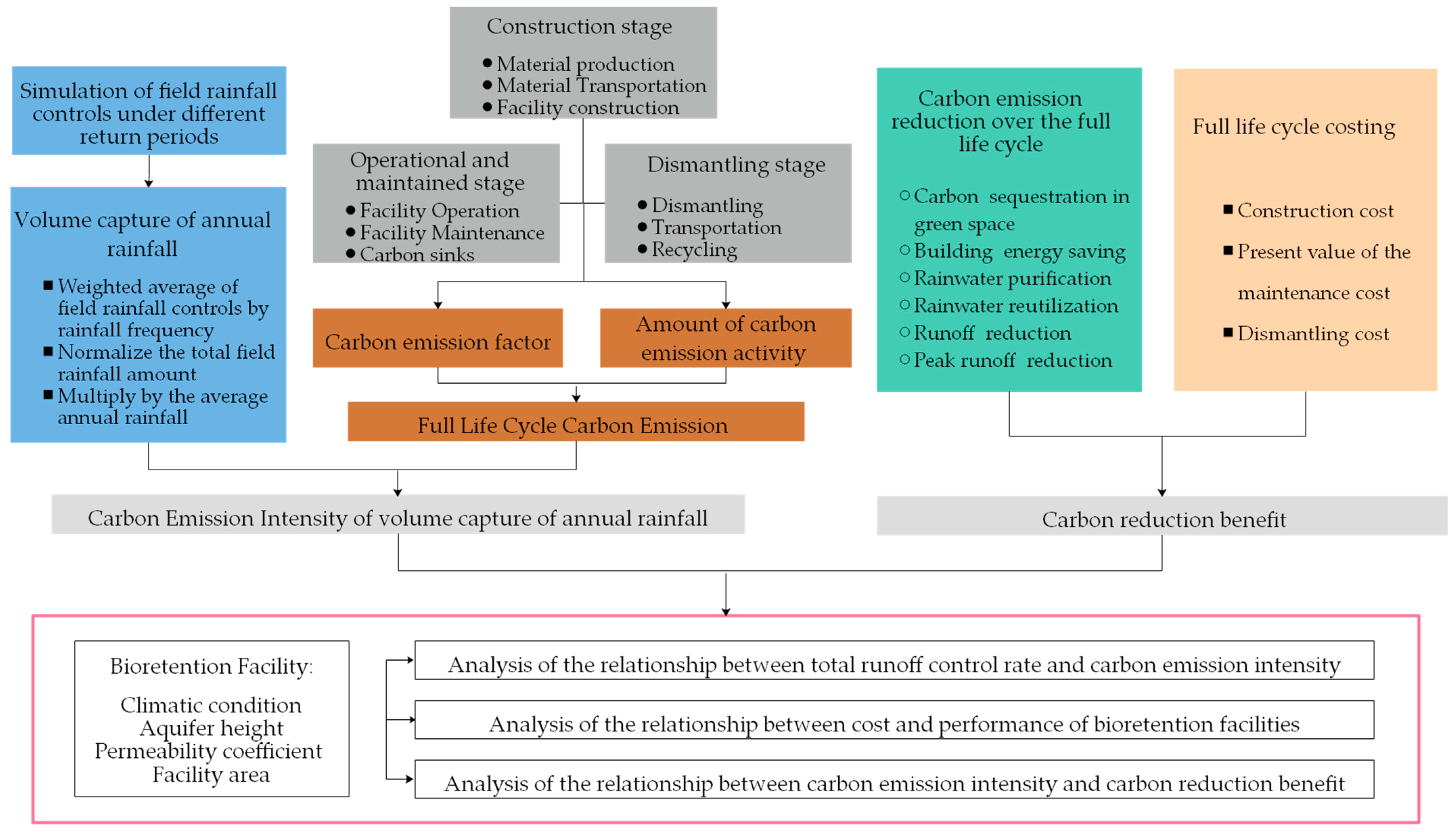
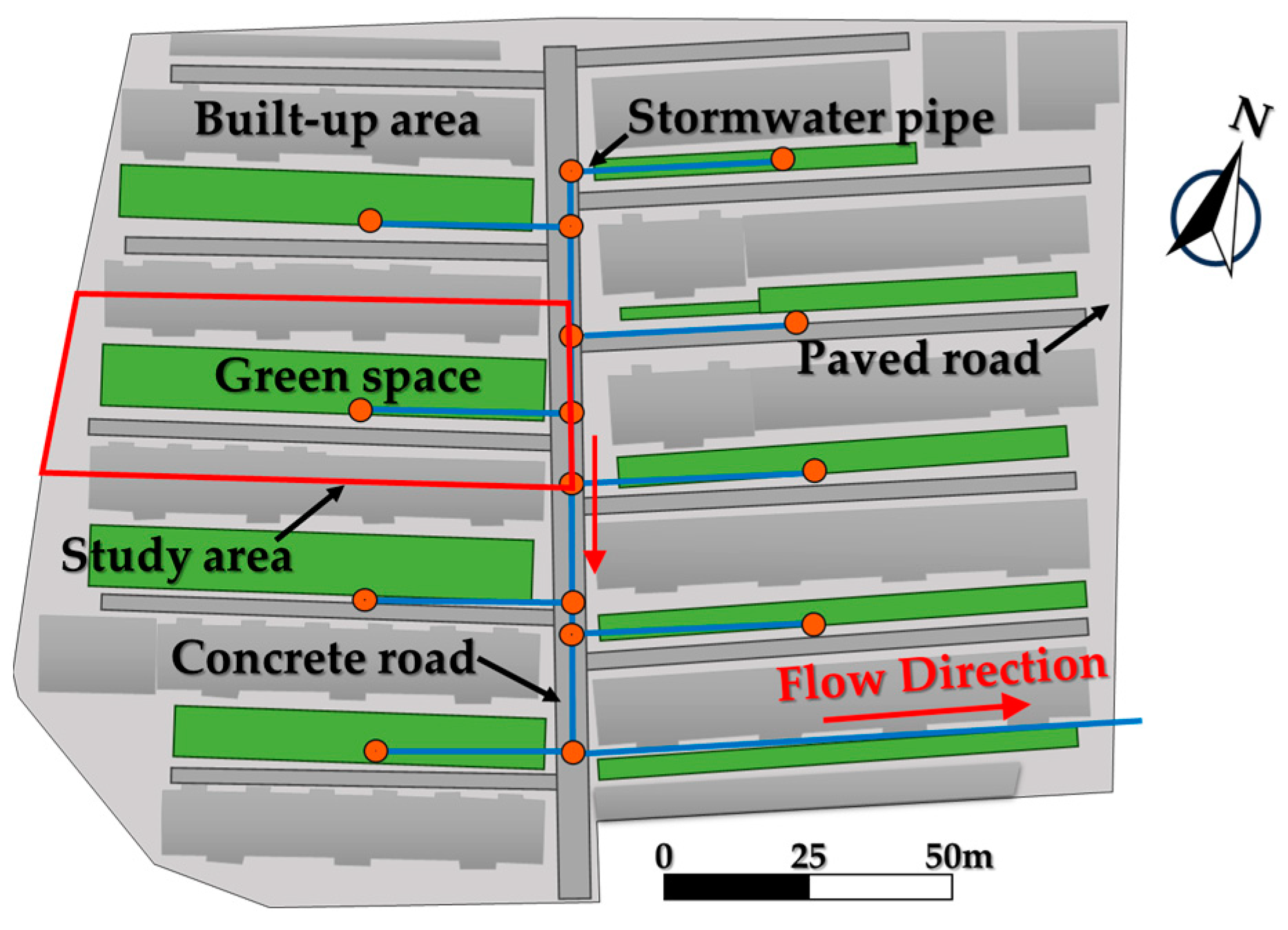

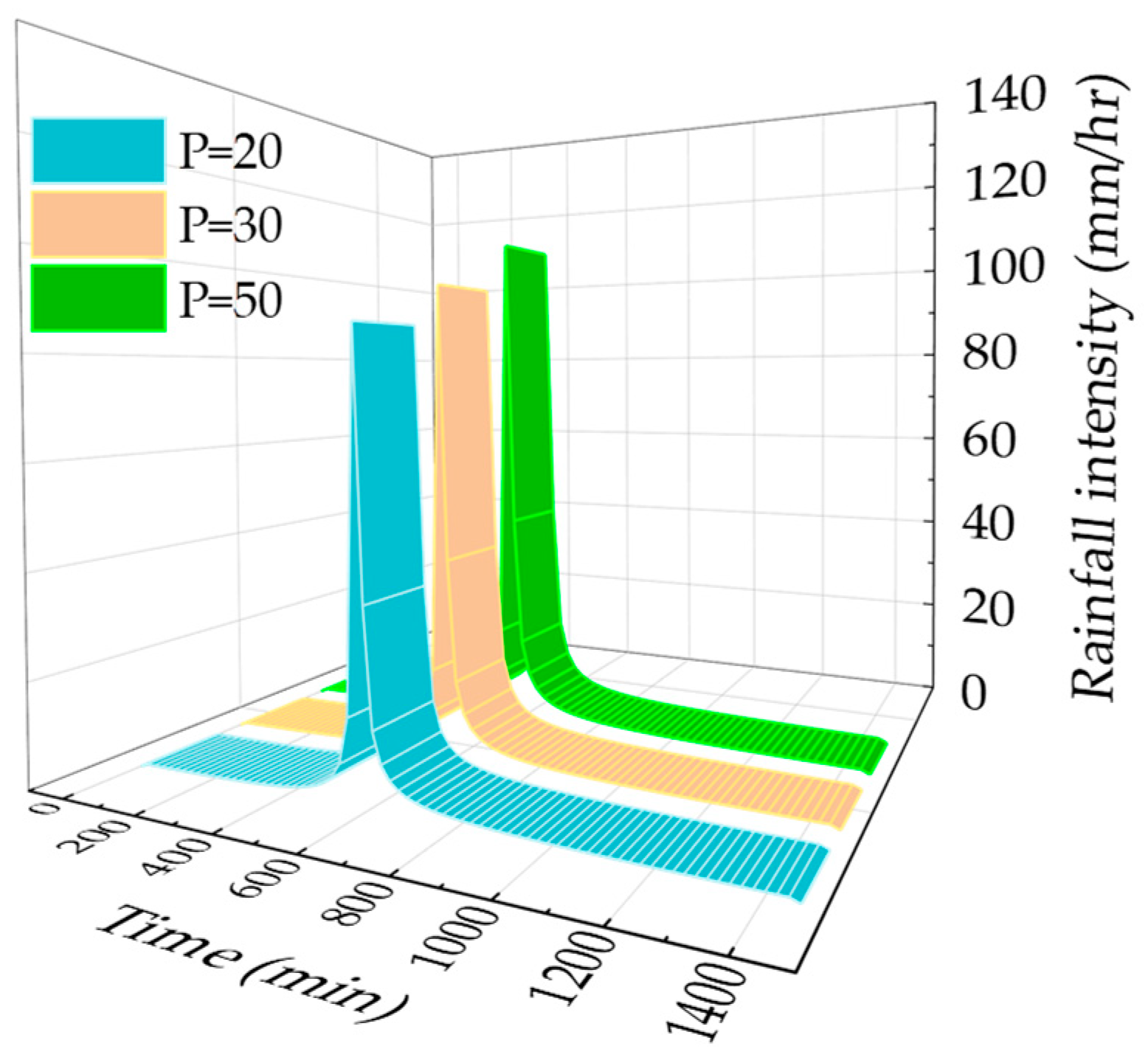
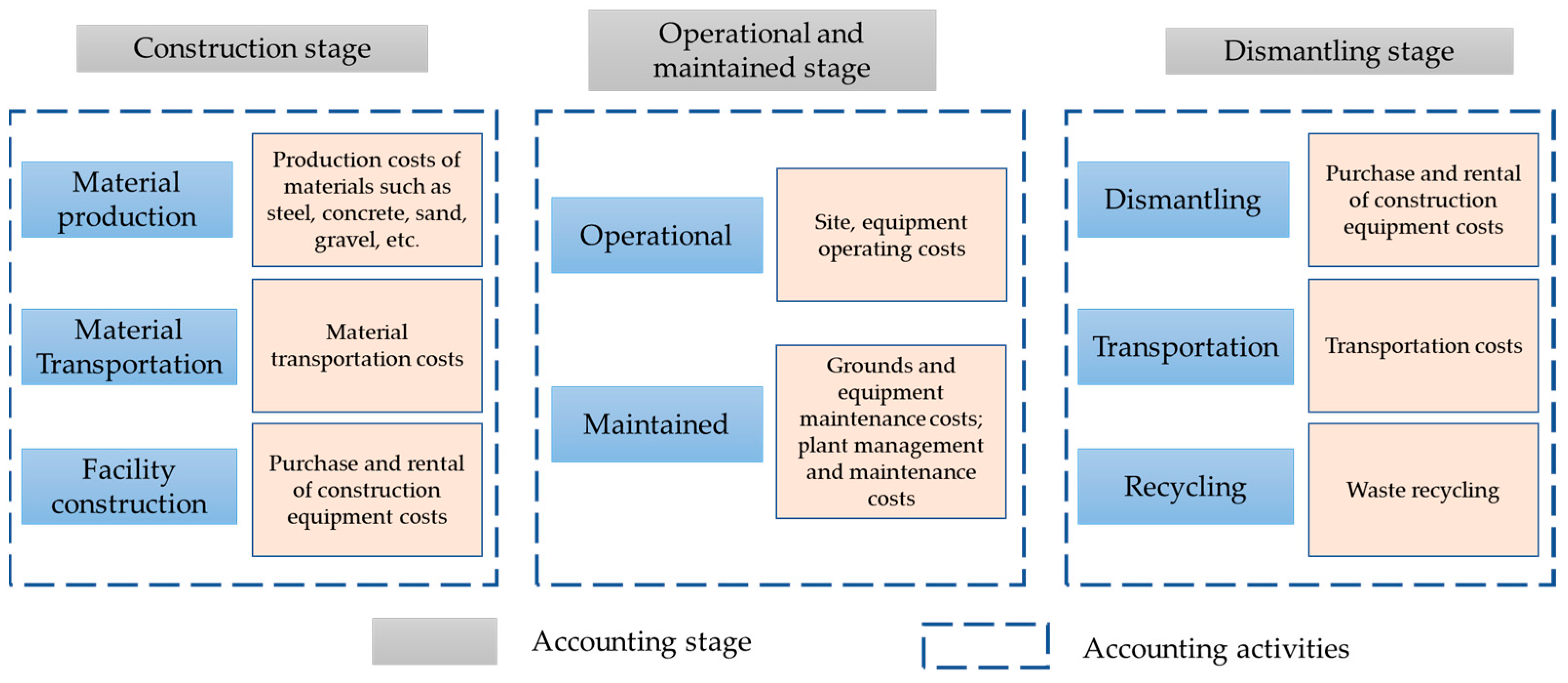
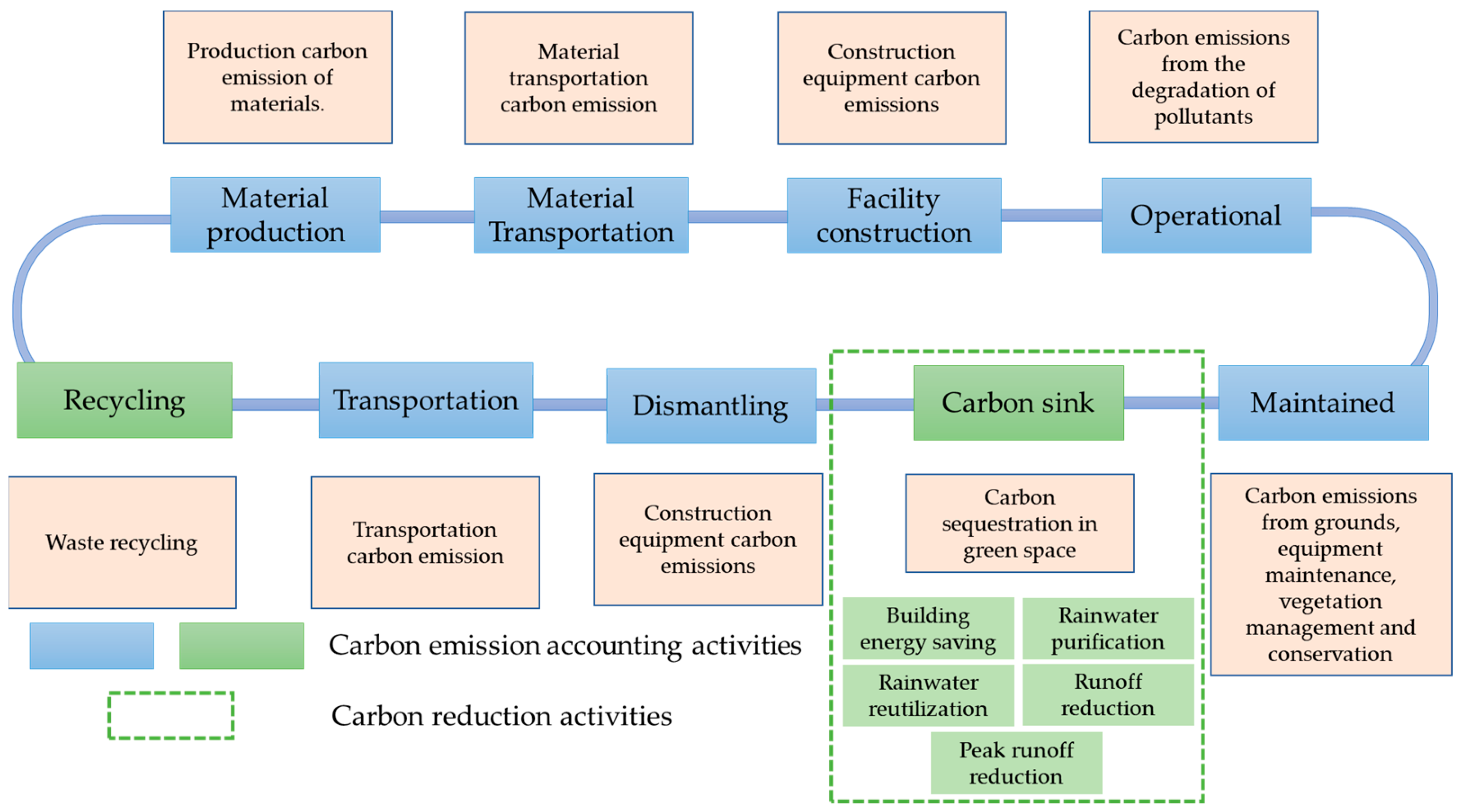



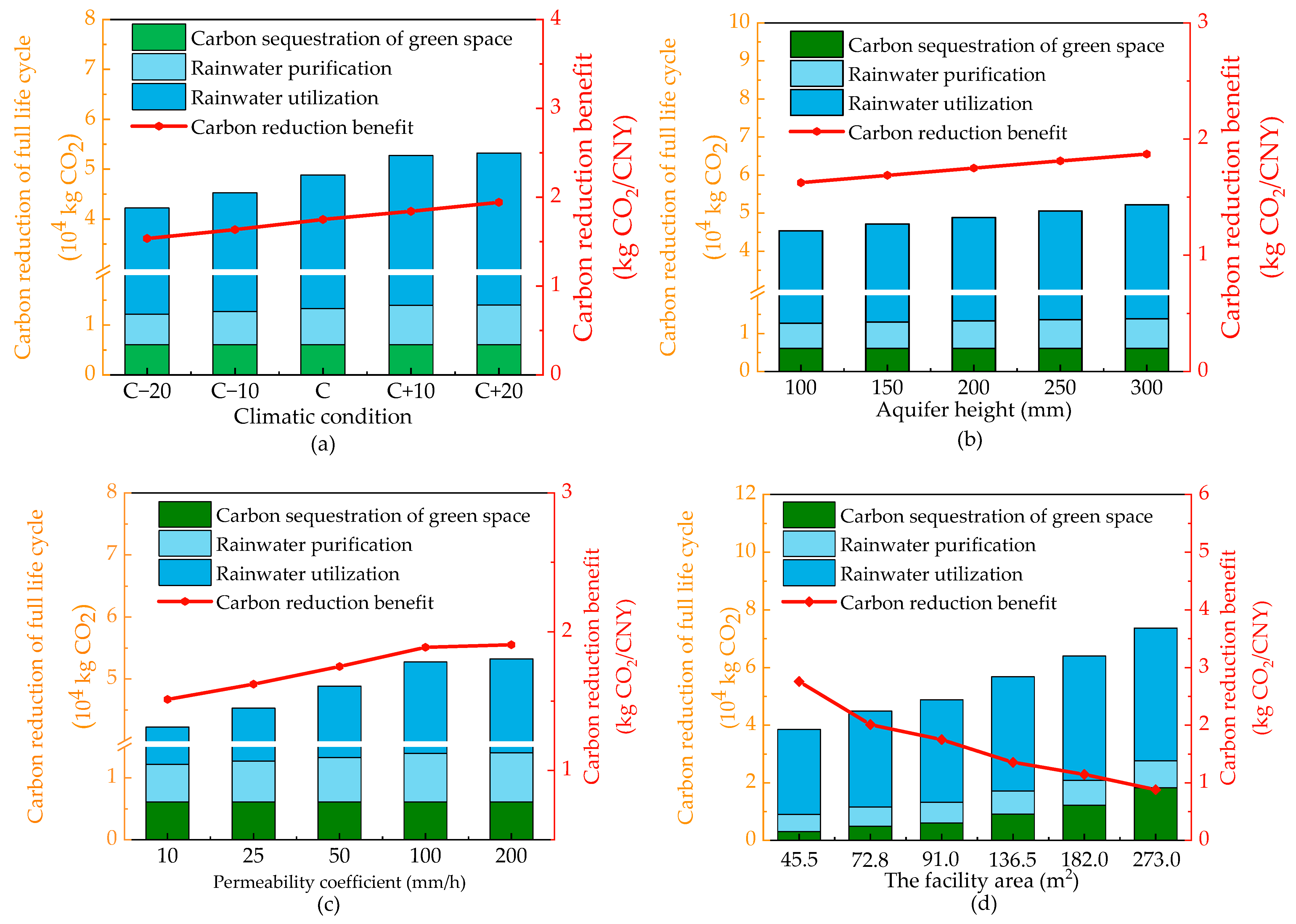
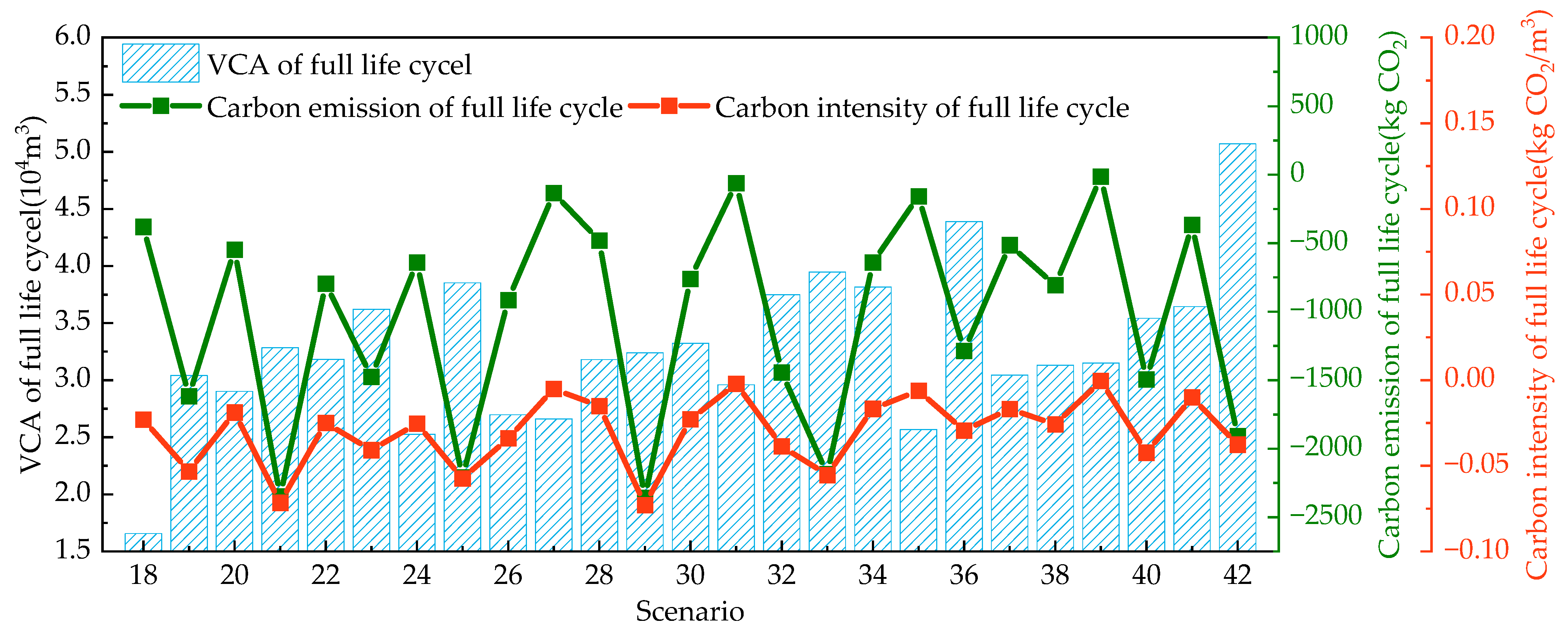
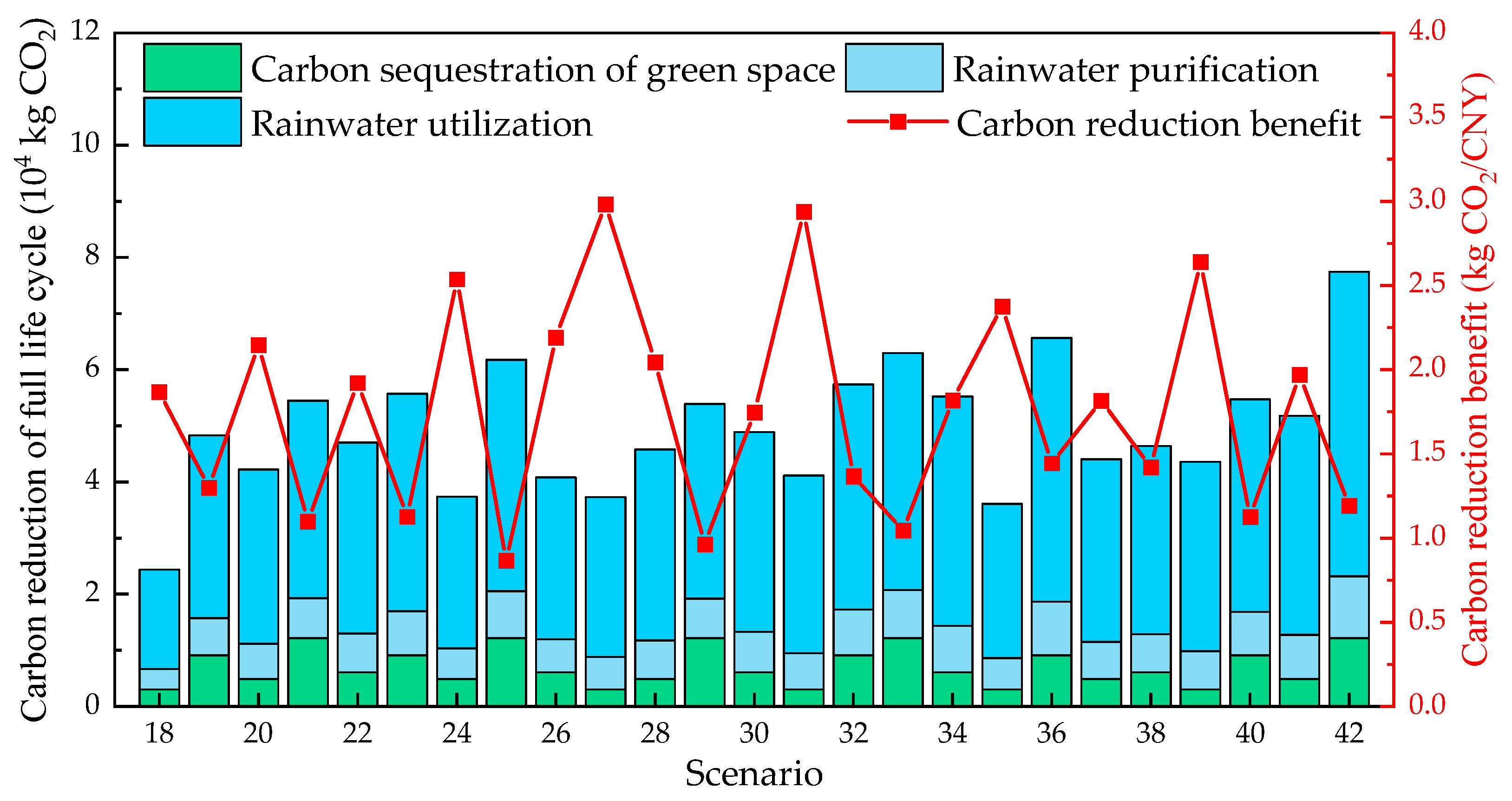

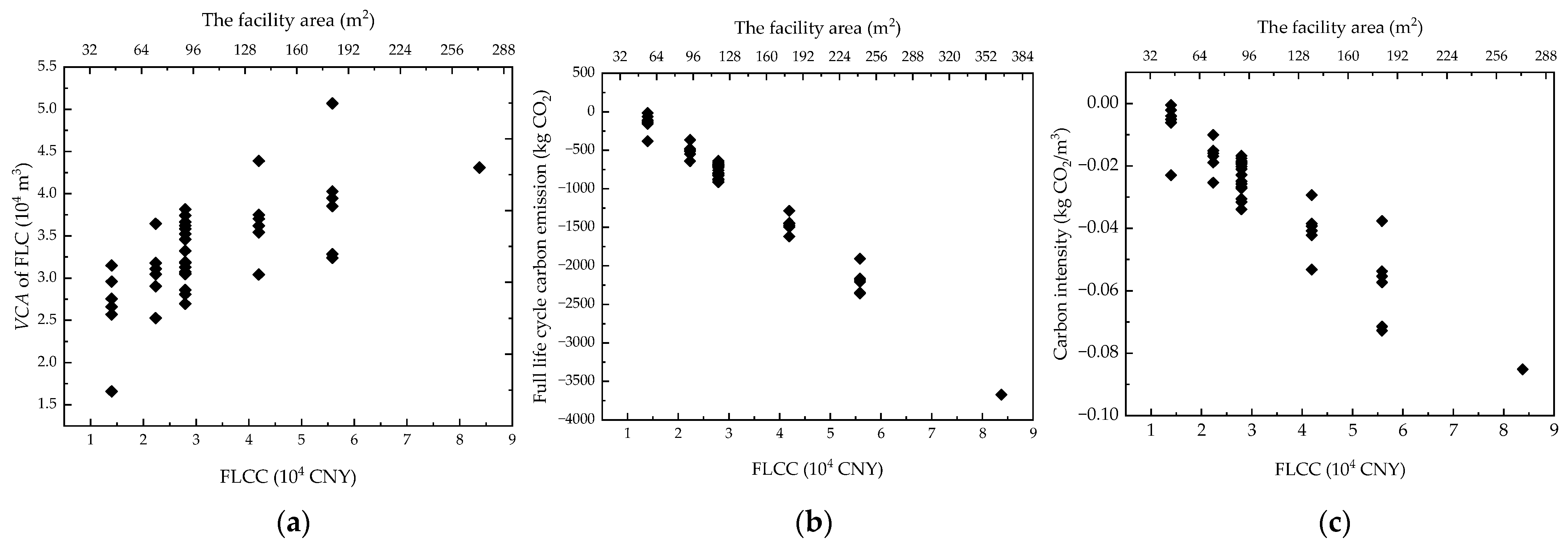
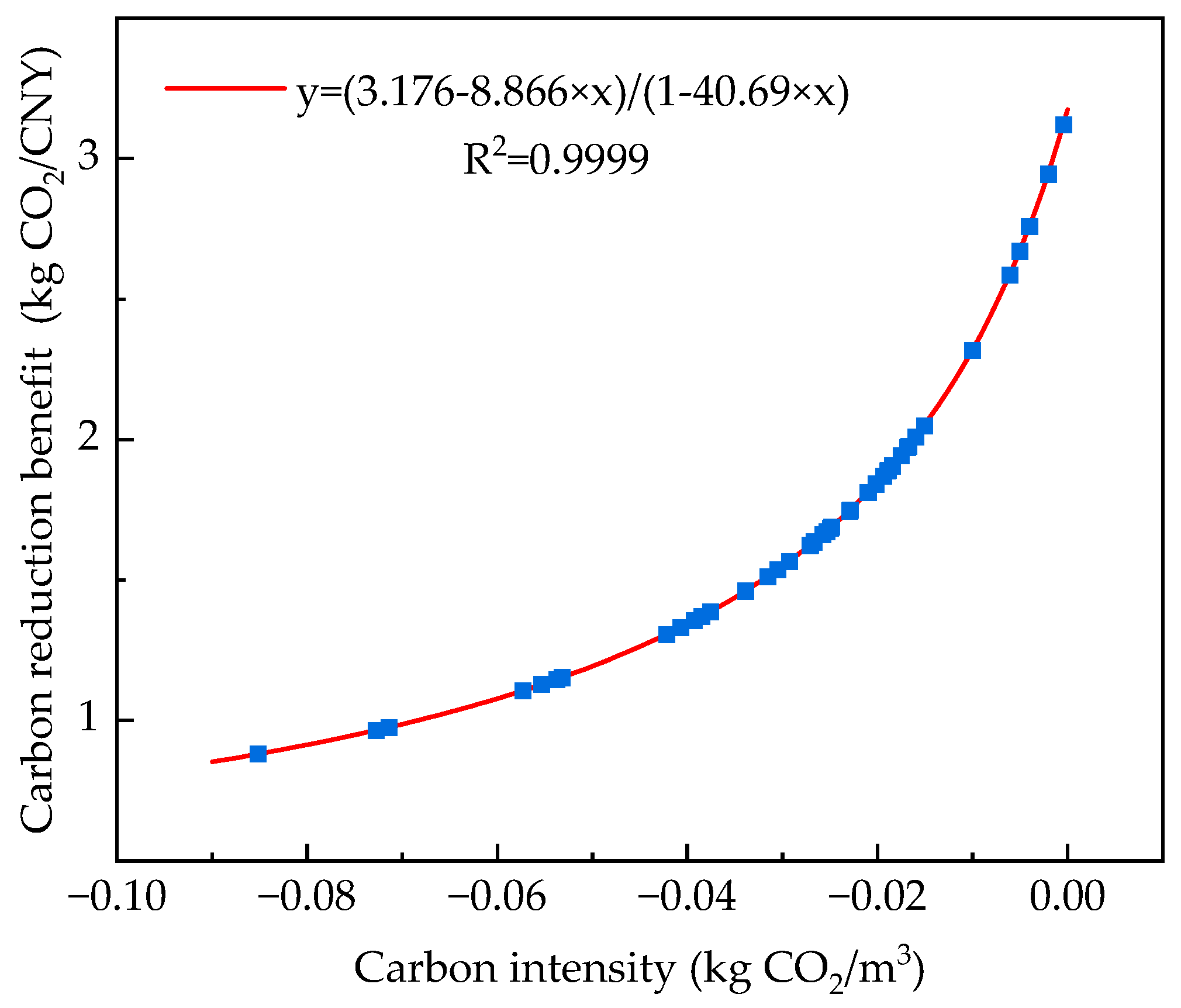
| Influencing Factor | Value | |||||||||
|---|---|---|---|---|---|---|---|---|---|---|
| Climatic condition 1 (CC) | C−20 | C−10 | C | C+10 | C+20 | |||||
| Aquifer height (AH) (mm) | 100 | 150 | 200 | 250 | 300 | |||||
| Permeability coefficient (PC) (mm/h) | 10 | 25 | 50 | 100 | 200 | |||||
| The facility area (FA) (m2) | 45.5 | 72.8 | 91 | 136.5 | 182 | 273 | ||||
| Scenario Number | Factors | Scenario Number | Factors | ||||||
|---|---|---|---|---|---|---|---|---|---|
| CC | AH (mm) | PC (mm/h) | FA (m2) | CC | AH (mm) | PC (mm/h) | FA (m2) | ||
| 1 | 0.8 | 200 | 50 | 91 | 22 | 0.8 | 300 | 100 | 91 |
| 2 | 0.9 | 200 | 50 | 91 | 23 | 0.9 | 100 | 200 | 136.5 |
| 3 | 1.1 | 200 | 50 | 91 | 24 | 0.9 | 150 | 25 | 72.8 |
| 4 | 1.2 | 200 | 50 | 91 | 25 | 0.9 | 200 | 100 | 182 |
| 5 | 1 | 100 | 50 | 91 | 26 | 0.9 | 250 | 10 | 91 |
| 6 | 1 | 150 | 50 | 91 | 27 | 0.9 | 300 | 50 | 45.5 |
| 7 | 1 | 250 | 50 | 91 | 28 | 1 | 100 | 100 | 72.8 |
| 8 | 1 | 300 | 50 | 91 | 29 | 1 | 150 | 10 | 182 |
| 9 | 1 | 200 | 10 | 91 | 30 | 1 | 200 | 50 | 91 |
| 10 | 1 | 200 | 25 | 91 | 31 | 1 | 250 | 200 | 45.5 |
| 11 | 1 | 200 | 100 | 91 | 32 | 1 | 300 | 25 | 136.5 |
| 12 | 1 | 200 | 200 | 91 | 33 | 1.1 | 100 | 50 | 182 |
| 13 | 1 | 200 | 50 | 45.5 | 34 | 1.1 | 150 | 200 | 91 |
| 14 | 1 | 200 | 50 | 72.8 | 35 | 1.1 | 200 | 25 | 45.5 |
| 15 | 1 | 200 | 50 | 136.5 | 36 | 1.1 | 250 | 100 | 136.5 |
| 16 | 1 | 200 | 50 | 182 | 37 | 1.1 | 300 | 10 | 72.8 |
| 17 | 1 | 200 | 50 | 273 | 38 | 1.2 | 100 | 25 | 91 |
| 18 | 0.8 | 100 | 10 | 45.5 | 39 | 1.2 | 150 | 100 | 45.5 |
| 19 | 0.8 | 150 | 50 | 136.5 | 40 | 1.2 | 200 | 10 | 136.5 |
| 20 | 0.8 | 200 | 200 | 72.8 | 41 | 1.2 | 250 | 50 | 72.8 |
| 21 | 0.8 | 250 | 25 | 182 | 42 | 1.2 | 300 | 200 | 182 |
| Constant | (kg CO2/m2) | (kg CO2/m2) | (kg CO2/m3) | (kg CO2/m2) | (kg CO2/m2) | (kg CO2/m3) |
|---|---|---|---|---|---|---|
| Value 1 | 44.2523 | 5.6710 | 3.7890 | 5.1300 | 66.9000 | 44.6160 |
| CC | AH | PC | FA | |
|---|---|---|---|---|
| K1 | −0.1513 | −0.1891 | −0.1813 | −0.0379 |
| K2 | −0.1637 | −0.1488 | −0.1565 | −0.0730 |
| K3 | −0.1603 | −0.1885 | −0.1476 | −0.1101 |
| K4 | −0.1489 | −0.1240 | −0.1611 | −0.2351 |
| K5 | −0.1639 | −0.1377 | −0.1415 | −0.3320 |
| R | 0.0150 | 0.0090 | 0.0150 | 0.0520 |
| CC | AH | PC | FA | |
|---|---|---|---|---|
| K1 | 8.3336 | 7.5071 | 7.9616 | 12.8031 |
| K2 | 9.7038 | 9.2546 | 8.7986 | 10.5100 |
| K3 | 9.0567 | 8.2575 | 9.0417 | 9.0959 |
| K4 | 8.4990 | 9.6396 | 8.9138 | 6.3631 |
| K5 | 8.3436 | 9.2779 | 9.2210 | 5.1646 |
| R | 0.4690 | 0.2700 | 0.4160 | 1.5020 |
Disclaimer/Publisher’s Note: The statements, opinions and data contained in all publications are solely those of the individual author(s) and contributor(s) and not of MDPI and/or the editor(s). MDPI and/or the editor(s) disclaim responsibility for any injury to people or property resulting from any ideas, methods, instructions or products referred to in the content. |
© 2024 by the authors. Licensee MDPI, Basel, Switzerland. This article is an open access article distributed under the terms and conditions of the Creative Commons Attribution (CC BY) license (https://creativecommons.org/licenses/by/4.0/).
Share and Cite
Wang, D.; Liu, X.; Li, H.; Chen, H.; Wang, X.; Li, W.; Cao, L.; Liu, J.; Zhang, T.; Wei, B. The Carbon Emission Intensity of Rainwater Bioretention Facilities. Water 2024, 16, 183. https://doi.org/10.3390/w16010183
Wang D, Liu X, Li H, Chen H, Wang X, Li W, Cao L, Liu J, Zhang T, Wei B. The Carbon Emission Intensity of Rainwater Bioretention Facilities. Water. 2024; 16(1):183. https://doi.org/10.3390/w16010183
Chicago/Turabian StyleWang, Deqi, Xuefeng Liu, Huan Li, Hai Chen, Xiaojuan Wang, Wei Li, Lianbao Cao, Jianlin Liu, Tingting Zhang, and Bigui Wei. 2024. "The Carbon Emission Intensity of Rainwater Bioretention Facilities" Water 16, no. 1: 183. https://doi.org/10.3390/w16010183
APA StyleWang, D., Liu, X., Li, H., Chen, H., Wang, X., Li, W., Cao, L., Liu, J., Zhang, T., & Wei, B. (2024). The Carbon Emission Intensity of Rainwater Bioretention Facilities. Water, 16(1), 183. https://doi.org/10.3390/w16010183






